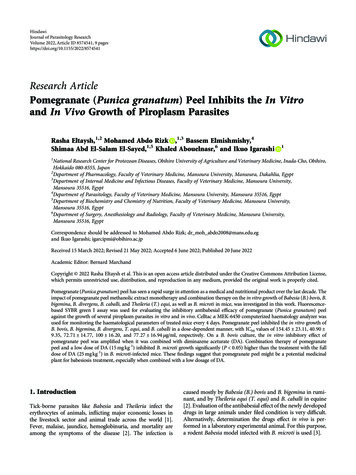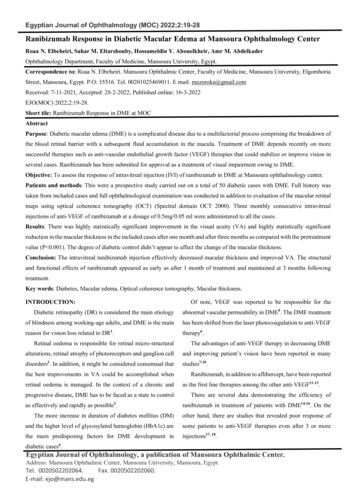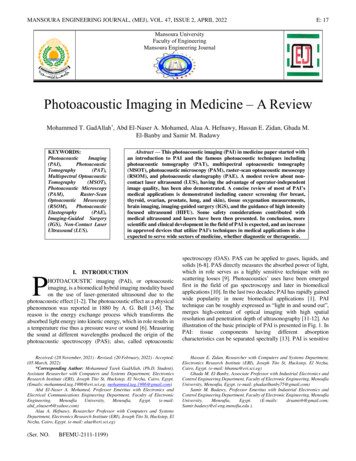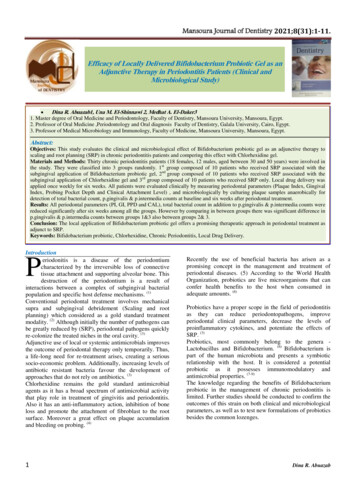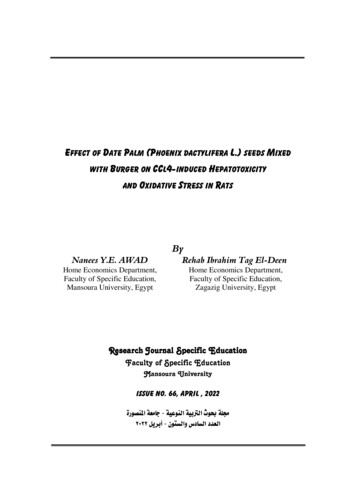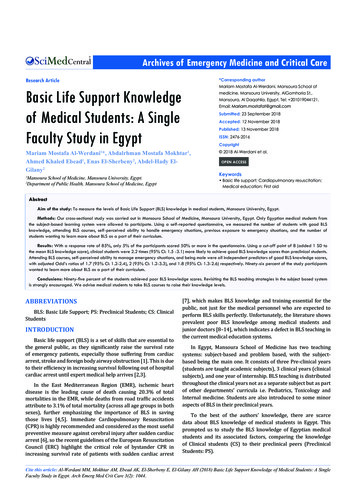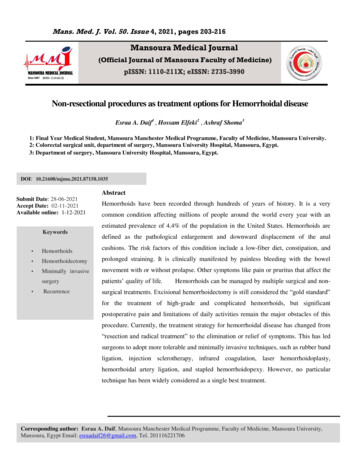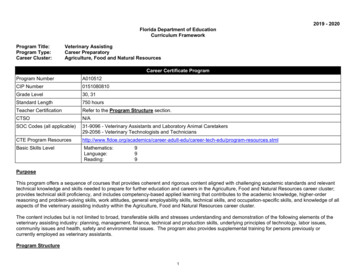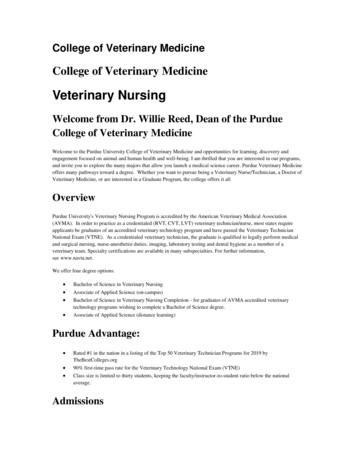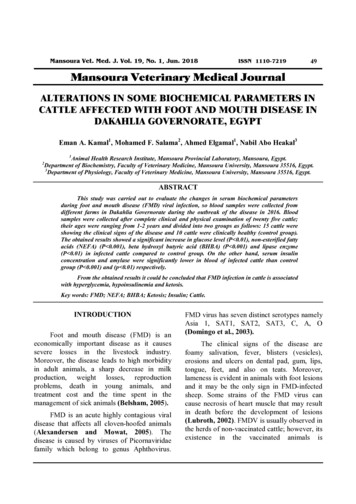
Transcription
Mansoura Vet. Med. J. Vol. 19, No. 1, Jun. 2018ISSN 1110-721949Mansoura Veterinary Medical JournalALTERATIONS IN SOME BIOCHEMICAL PARAMETERS INCATTLE AFFECTED WITH FOOT AND MOUTH DISEASE INDAKAHLIA GOVERNORATE, EGYPTEman A. Kamal1, Mohamed F. Salama2, Ahmed Elgamal1, Nabil Abo Heakal312Animal Health Research Institute, Mansoura Provincial Laboratory, Mansoura, Egypt.Department of Biochemistry, Faculty of Veterinary Medicine, Mansoura University, Mansoura 35516, Egypt.3Department of Physiology, Faculty of Veterinary Medicine, Mansoura University, Mansoura 35516, Egypt.ABSTRACTThis study was carried out to evaluate the changes in serum biochemical parametersduring foot and mouth disease (FMD) viral infection, so blood samples were collected fromdifferent farms in Dakahlia Governorate during the outbreak of the disease in 2016. Bloodsamples were collected after complete clinical and physical examination of twenty five cattle;their ages were ranging from 1-2 years and divided into two groups as follows: 15 cattle wereshowing the clinical signs of the disease and 10 cattle were clinically healthy (control group).The obtained results showed a significant increase in glucose level (P 0.01), non-esterified fattyacids (NEFA) (P 0.001), beta hydroxyl butyric acid (BHBA) (P 0.001) and lipase enzyme(P 0.01) in infected cattle compared to control group. On the other hand, serum insulinconcentration and amylase were significantly lower in blood of infected cattle than controlgroup (P 0.001) and (p 0.01) respectively.From the obtained results it could be concluded that FMD infection in cattle is associatedwith hyperglycemia, hypoinsulinemia and ketosis.Key words: FMD; NEFA; BHBA; Ketosis; Insulin; Cattle.INTRODUCTIONFoot and mouth disease (FMD) is aneconomically important disease as it causessevere losses in the livestock industry.Moreover, the disease leads to high morbidityin adult animals, a sharp decrease in milkproduction, weight losses, reproductionproblems, death in young animals, andtreatment cost and the time spent in themanagement of sick animals (Belsham, 2005).FMD is an acute highly contagious viraldisease that affects all cloven-hoofed animals(Alexandersen and Mowat, 2005). Thedisease is caused by viruses of Picornaviridaefamily which belong to genus Aphthovirus.FMD virus has seven distinct serotypes namelyAsia 1, SAT1, SAT2, SAT3, C, A, O(Domingo et al., 2003).The clinical signs of the disease arefoamy salivation, fever, blisters (vesicles),erosions and ulcers on dental pad, gum, lips,tongue, feet, and also on teats. Moreover,lameness is evident in animals with foot lesionsand it may be the only sign in FMD-infectedsheep. Some strains of the FMD virus cancause necrosis of heart muscle that may resultin death before the development of lesions(Lubroth, 2002). FMDV is usually observed inthe herds of non-vaccinated cattle; however, itsexistence in the vaccinated animals is
Eman A. Kamal. et al indicative of vaccination failure (Abubakar etal., 2014).Animals that are infected with FMDVusually show ulcers on tongue and off food toavoid pain; therefore, they have negativeenergy balance (NEB) that leads to massivemobilization of non-esterified fatty acids(NEFA) from the adipose tissue (Bell, 1997),which results from the induction of hormonesensitive lipase release and subsequentlipolysis (Melendez et al., 2009).Incomplete oxidation of NEFA in theliver leads to formation of ketone bodies (βhydroxyl butyrate, acetoacetate and acetone)with subsequent ketosis (Drackley et al. 2005).NEFA and BHBA are the most commonindicators for evaluation of lipid mobilizationand ketosis (González, 2011).Ketosis is a metabolic disorder whichoccurs in adult cattle. It occurs when thedemand of energy is more than energy intake(Grummer, 1993). Ketosis in cattle is still notcompletely understood, but it needs thecombination of adipose mobilization fromintestine and a high glucose demand.Therefore, the description of ketosis includeshigh serum level of ketone bodies and NEFA(Oetzel, 2004).NEFAs prompt phosphorylation ofinsulin receptor substrate 1 (IRS-1) on serineresidues that leads to a reduction in insulininduced tyrosine phosphorylation of IRS-1,which is important for normal activation ofinsulin signaling cascade (LeMarchandBrustel et al., 2003).The biochemical alterations associatedwith FMD viral infection in cattle are notclearly understood. Therefore, the current studyaimed to examine the effect of FMDV onsome biochemical parameters in infectedcattle.Mansoura Vet. Med. J.50MATERIAL AND METHODS2.1. AnimalsThis study was carried out on twenty fivecattles from different farms in DakahliaGovernorate, Egypt. Animals were assignedinto two groups: the first one was consisting of15 cattle which showed the clinicalcharacteristic of FMD. The second group(control group) was consisted of 10 cattles thatwere apparently clinically healthy. The animalswere thoroughly examined and were free fromparasitic infestation.2.2. SamplesBlood samples were collected from cattleof both groups from the jugular vein either intofluoride containing tubes for estimation ofblood glucose or plain tubes for serumseparation. Serum was collected from the plaintubes by centrifugation at 10 minutes at 3000rpm, and serum samples were then stored at 20 C until used to determine somebiochemical parameters.2.3. Biochemical analysisGlucose was determined according toTrinder, (1969), insulin according toChevenne et al, (1998), NEFA according toSmith and Wilson, (2006), BHBA accordingto Young D.S (2000), lipase according to SteerA.C.et al., (2009) and amylase according toWinn-Deen,E.S.,et al.,(2005).2.4. Statistical analysisData were statistically analyzed by usingstudent’s t-test by using GraphPad prismVol. 19, No. 1, 2018
Eman A. Kamal. et al (GraphPad Software, Incorporated, La Jolla,CA, USA) and were presented as mean standard error of mean. P values of 0.05 wereconsidered to be statistically significant(Scendecor GW, and Cochran WG,1969).RESULTSFMD-infected cattle showed typicalclinical signs including foamy salivation, ulcerson the dental pad, and recumbency (Figure 1).51Results of the biochemical variables incontrol and FMD-infected animals arepresented in table (1).The data showed a significant increas(p 0.05) in NEFA, BHBA- concentrations aswell as serum glucose level and lipase activityin FMD-infected cattle compared to that ofthe control group. On the other hand, there wasa significantreduction (p 0.05) in the seruminsulinlevelandamylaseactivityin the diseasedanimals compared tothe control.Figure (1). Clinical signs of FMD-infected cattle. The observed clinical signs included:ulcers on the dental pad (a) and foamy salivation and recumbency (b) in FMDinfected cattle.Mansoura Vet. Med. J.Vol. 19, No. 1, 2018
Eman A. Kamal. et al 52Table (1). Serum biochemical parameters in control and FMD-infected cattle (mean SE).Parameter**, ***Healthy animals(n 10)FMD infected animals (n 15)NEFA (mmol/L)0.28 0.021.28 0.14***BHBA (mmol/L)0.87 0.013.00 0.16***Glucose(mg/dl)48.67 1.668.2 3.8**Lipase (U/L)29.5 7.471.2 8.7**Insulin (µLU/ml)10.61 0.4915.9 0.68***Amylase (U/L)25.5 2.413.5 1.8**denotes statistical significant differences compared to control group.DISCUSSIONThe current study aimed to investigatebiochemical alterations associated with FMDinfection in cattle. Our results showedhyperglycemia and hypoinsulinemia in FMDinfected cattle. Hyperglycemia is a commonfinding in animals affected by systemicdiseases due to stresses (Yeotikar et al., 2003;Gokce et al., 2004 and Paalberg et al., 2002).The reason behind increased glucose level anddecreased insulin concentration could also bedue to the destruction of islets of Langerhans ofpancreatic -cells subsequent to FMD viralinfection (Sutmoller et al. 2003). Moreover, itwas suggested that low insulin concentrationsmay be due to alterations in pancreatic -cellfunctions developed during the clinical courseof FMD (Barboni, 1966).Hyperglycemia and diabetes may occurduring FMD viral infection in cattle by twodifferent mechanisms; the direct destructionpancreatic -cells by the virus or by theautoimmune response that develops against thevirus (Clark, 2003).Mansoura Vet. Med. J.The increased NEFA concentration in theFMD-infected cattle could be attributed toreduction in feed intake with subsequentincrease in energy demand that leads tonegative energy balance (NEB) andcompensation by mobilization of NEFA fromadipose tissues (Baird, 1982). Increased fatmobilization is evident in our study by theobserved increase in lipase in FMD-infectedcattle (table, 1).Increased BHBA concentrations in FMDinfected cattle is indicative of excessive fatmobilization and subsequent ketosis. Excessivefat mobilization is usually accompanied by amarked formation of acetyl-coenzyme A andthe tricarboxylic acid cycle cannot fullymetabolize fatty acids. Therefore, acetylcoenzyme A is converted to acetoacetate whichis then reduced to BHBA by BHBAdehydrogenaseorspontaneouslydecarboxylated into acetone (Baird, 1982;Brumby et al., 1975).Part of the mobilized body fat will beconverted to ketones in the liver which leads toincrease the concentration of ketones in theblood. Once the metabolic and endocrineVol. 19, No. 1, 2018
Eman A. Kamal. et al systems are unable to regulate NEB, ketonebody production increases rapidly, and ketosisbecomes unavoidable (Herdt, 2000).High BHBA concentrations of (more than1 mmol/L) (table, 1) was accompanied byhigher insulin resistance and higher NEFAsconcentrations were correlated with a lowerinsulin secretion significantly (Kerestes M., etal., 2009). That could also explain the observedhypoinsulinemia in our present study.In the present study, we showed thatFMD infection in cattle is associated with adecrease in serum amylase levels. Krehbiel etal., (1995) reported that blood amylase activityis used as a clinical laboratory test in diagnosisof acute pancreatitis. On the other hand,(Mohamed et al. 2003) found that the serumamylase level in cows with chronic pancreatitisremains normal.Patients with very low serum insulinshowed a reduction in serum amylase. Asimilar decrease in serum amylase wasobserved in diabetic rats that was reversed byinsulin injection (Patel et al., 2006).Pancreasweight was significantly decreased in animalswhich have elevated blood glucose and lowplasma insulin levels compared to the healthycontrol also diabetic animals eat less andmoreover, they produce less digestive enzymes,especially amylase (Singh,J., E,etal.2004).CONCLUSIONThis study suggests that FMD virus has adeleterious effect on the pancreatic cells that isevident by the decrease in serum insulin leveland amylase activity with subsequenthyperglycemia. Moreover, FMD infection isalso associated with ketosis as evidenced byincreased serum BHBA levels.Mansoura Vet. Med. J.53REFERENCESAbubakar, M., Jamil, A., & Ali, Q. (2014).An evaluation of foot–and–mouthdisease outbreak in relation tovaccination in a herd of cattle andbuffaloes. ResearchJournalforVeterinary Practitioners, 2(2), 28-9.Alexandersen, S., & Mowat, N. (2005). Footand-mouth disease: host range andpathogenesis.In Foot-and-MouthDisease Virus (pp. 942).Baird, G. D. (1982). Primary ketosis in thehigh-producing dairy cow: clinical andsubclinicaldisorders,treatment,prevention, and outlook. Journal ofDairy Science, 65(1), 1-10.Barboni, E., Mannocchio, I., & Asdrubali,G. (1966). The development of diabetesmellitus in cattle experimentallyinfected with virus of foot and mouthdisease. Vet. Ital, 17, 339-368.Bell, A. W., & Bauman, D. E. (1997).Adaptations of glucose metabolismduring pregnancy and lactation. Journalof mammary gland biology andneoplasia, 2(3), 265-278.Belsham, G. J. (2005). Translation andreplication of FMDV RNA. In Footand-Mouth Disease Virus (pp. 4370).Springer Berlin Heidelberg.Brumby, P. E., Anderson, M. A. L. C. O. L.M., Tuckley, B. R. I. A. N., Storry, J.E., & Hibbit, K. G. (1975). Lipidmetabolism in the cow duringstarvation-induced ketosis. BiochemicalJournal, 146(3), 609-615.Chevenne D, Letailleur, A, Trivin FandPorquet D. (1998): Effect ofhemolysis on the concentration ofVol. 19, No. 1, 2018
Eman A. Kamal. et al insulin determined by RIA IRMA. ClinChem., 44,354-6.Clark, Z. (2003). Diabetes mellitus in a 6month-old Charolais heifer calf. TheCanadian Veterinary Journal, 44(11),921.Domingo, E., Escarmı́s, C., Baranowski, E.,Ruiz-Jarabo, C. M., Carrillo, E.,Núñez, J. I., & Sobrino, F. (2003).Evolution of foot-and-mouth diseasevirus. Virus research, 91(1), 47-63.Drackley, J. K., Dann, H. M., Douglas, N.,Guretzky, N. A. J., Litherland, N. B.,Underwood, J. P., & Loor, J. J.(2005). Physiological and pathologicaladaptations in dairy cows that mayincrease susceptibility to periparturientdiseases and disorders. Italian Journalof Animal Science, 4(4), 323-344.Gökçe, G., Gökçe, H. İ., Günes, V., Erdogan,H. M., & Çitil, M. (2004). Alterationsinsomehaematologicalandbiochemical parameters in cattlesufferingfromfoot-and-mouthdisease. Turkish Journal of Veterinaryand Animal Sciences, 28(4), 723-727.González, F. D., Muiño, R., Pereira, V.,Campos, R., & Benedito, J. L. (2011).Relationship among blood indicators oflipomobilization and hepatic functionduring early lactation in high-yieldingdairy cows. Journal of veterinaryscience, 12(3), 251-255.Grummer, R. R. (1993). Etiology of lipidrelatedmetabolicdisordersinperiparturient dairy cows. Journal ofDairy Science, 76(12),3882-3896.Herdt TH (2000). Ruminant adaptation tonegative energy balance. Influences onthe etiology of ketosis and fatty liver.Veterinary Clinics of North AmericaFood Animal Practice 16: 215–230.Mansoura Vet. Med. J.54Kerestes, M., Faigl, V., & Kulcsar, M.(2009). Periparturient insulin secretionand whole-body insulin responsivenessin dairy cows showing various forms ofketone pattern with or withoutpuerperal metritis. Domestic AnimalEndocrinology, 37(4), 250–261.Krehbiel, C. R., Britton, R. A., Harmon, D.L., Wester, T. J., & Stock, R. A.(1995). The effects of ruminal acidosison volatile fatty acid absorption andplasma activities of pancreatic enzymesinlambs. Journalofanimalscience, 73(10), 3111-3121.LeMarchand-Brustel, Y., Gaul, P.,Gremeaux, T., Gonzalez, T., Barres,R., & Tanti, J.F. (2003). Fatty acidinduced insulin resistance: role ofinsulin receptor substrate 1 serinephosphorylation in the retroregulationof insulin signalling. BiochemicalSociety Transactions, 31, 1152–1156.Lubroth, J. (2002). Foot-and-mouth disease:Areviewforthepractitioner. Veterinary Clinics of NorthAmerica: Food Animal Practice, 18(3),475-499.Melendez, P., Marin, M. P., Robles, J., Rios,C., Duchens, M., & Archbald, L.(2009). Relationship between serumnonesterified fatty acids at calving andthe incidence of periparturient diseasesinHolsteindairycows. Theriogenology, 72(6), 826-833.Mohamed, T., Sato, H., Kurosawa, T.,Oikawa, S., & Nitanai, A. (2003).Ultrasonographicimagingofexperimentally induced pancreatitis incattle. The Veterinary Journal, 165(3),314-324.Oetzel, G. R. (2004). Monitoring and testingdairyherdsformetabolicVol. 19, No. 1, 2018
Eman A. Kamal. et al disease. VeterinaryClinics:FoodAnimal Practice, 20(3), 651-674.Paarlberg, P. L., Lee, J. G., & Seitzinger, A.H. (2002). Potential revenue impact ofan outbreak of foot-and-mouth diseasein the United States. Journal of theAmericanVeterinaryMedicalAssociation, 220(7), 988-992.Patel, R., Pariente, J. A., Martinez, M. A.,Salido, G. M., & Singh, J. (2006).Effect of Insulin on AcetylcholineEvoked Amylase Release and CalciumMobilization in ells. Annals of the New York Academyof Sciences, 1084(1), 58-70.Scendecor GW, and Cochran WG, StatisticalMethods. 6th ed. Ames: Iowa StateUniversity Press; 1969. pp. 59-65.Singh,J., E.Adeghate, S.Aparico, etal . 2004. Exocrinepancreaticinsufficiency in diabetes mellitus. Int. J.Diabetes Metab. 12: 35–43.Mansoura Vet. Med. J.55Smith and Wilson. Free Fatty Acids andAtherosclerosis. J Clin Endocrinol SteerA.C.et al., Clin.Vac. immunology,16,172 (2009).Stockham, S. L., & Scott, M. A. (2013).Fundamentals of veterinary clinicalpathology. John Wiley & Sons.Sutmoller, P., Barteling, S. S., Olascoaga, R.C., & Sumption, K. J. (2003). Controland eradication of foot-and-mouthdisease. Virus research, 91(1), 101-144.Trinder P. (1969):Colorimetric determinationof glucose Ann. Clin. Biochem, 6, 24.Winn-Deen,E.S.,et al., development of adirect assay for a amylase, Yeotikar,P. V., Bapat, S. T., Bilolikar, S. C., &Kulkarni, S. S. (2003). Metabolicprofile of healthy cattle and cattleaffectedbyfoot-and-mouthdisease. Veterinary record, 153(1), 1920.Young D.S., Effect of drugs on clinical Lab.Test, 5th Ed. AACC Press(2000).Vol. 19, No. 1, 2018
Eman A. Kamal. et al 56 – ﻣﻌﮭﺪ اﻟﺒﺤﻮث اﻟﺼﺤﯿﺔ اﻟﺤﯿﻮاﻧﯿﺔ ، اﻟﻤﻌﻤﻞ اﻟﻔﺮﻋﻲ ﺑﺎﻟﻤﻨﺼﻮرة ، اﻟﻤﻨﺼﻮرة ، ﻣﺼﺮ .١ ﻗﺴﻢ اﻟﻜﯿﻤﯿﺎء اﻟﺤﯿﻮﯾﺔ ، ﻛﻠﯿﮫ اﻟﻄﺐ اﻟﺒﯿﻄﺮي ، ﺟﺎﻣﻌﮫ اﻟﻤﻨﺼﻮرة ، اﻟﻤﻨﺼﻮرة ، ٣٥٥١٦ ﻣﺼﺮ . ﻗﺴﻢ اﻟﻔﺴﯿﻮﻟﻮﺟﯿﺎ ، ﻛﻠﯿﮫ اﻟﻄﺐ اﻟﺒﯿﻄﺮي ، ﺟﺎﻣﻌﮫ اﻟﻤﻨﺼﻮرة ، اﻟﻤﻨﺼﻮرة ، ٣٥٥١٦ ﻣﺼﺮ .٣ ٢ أﺟﺮﯾﺖ ھ ﺬه اﻟﺪراﺳ ﺔ ﻟﻤﻌﺮﻓ ﺔ اﻟﺘﻐﯿ ﺮات ﻓ ﻲ اﻟﻤﻌ ﺎﯾﯿﺮ اﻟﺒﯿﻮﻛﯿﻤﯿﺎﺋﯿ ﺔ ﻓ ﻲ ﻣ ﺼﻞ دم اﻷﺑﻘ ﺎر اﻟﻤ ﺼﺎﺑﺔ ﺑﻤ ﺮض اﻟﺤﻤ ﻰ اﻟﻘﻼﻋﯿﺔ . ﺗﻢ ﺟﻤﻊ ﻋﯿﻨﺎت دم اﻷﺑﻘﺎر ﻣ ﻦ ﻣ ﺰارع ﻣﺨﺘﻠﻔ ﺔ ﻓ ﻲ ﻣﺤﺎﻓﻈ ﺔ اﻟﺪﻗﮭﻠﯿ ﺔ ﺑﻌ ﺪ إﺟ ﺮاء ﻓﺤ ﺺ ﺳ ﺮﯾﺮي وﺑ ﺪﻧﻲ ﺷ ﺎﻣﻞ ﻟﺨﻤﺴﺔ وﻋﺸﺮﯾﻦ ﺑﻘﺮة ﺗﺘﺮاوح أﻋﻤﺎرھﺎ ﺑﯿﻦ ) ٢-١ ﺳﻨﺔ( واﻟﺘﻲ ﻗﺴﻤﺖ ﻋﻠﻰ ﻣﺠﻤﻮﻋﺘﯿﻦ ﺣﯿﺚ ﺗﺘﻀﻤﻦ اﻟﻤﺠﻤﻮﻋ ﺔ اﻻوﻟ ﻰ ١٥ ﺑﻘﺮة أﻇﮭﺮت اﻟﻌﻼﻣﺎت اﻟ ﺴﺮﯾﺮﯾﺔ ﻟﻠﻤ ﺮض ﻓﯿﻤ ﺎ ﺗﺘ ﻀﻤﻦ اﻟﻤﺠﻤﻮﻋ ﺔ اﻟﺜﺎﻧﯿ ﺔ ١٠ أﺑﻘ ﺎر ﺳ ﻠﯿﻤﺔ ﻣ ﻦ اﻹﺻ ﺎﺑﺔ ﺑ ﺎﻟﻤﺮض )اﻟﻤﺠﻤﻮﻋ ﺔ اﻟ ﻀﺎﺑﻄﺔ( وﺑﯿﻨ ﺖ ﻧﺘ ﺎﺋﺞ اﻟ ﺼﻮرة اﻟﺒﯿﻮﻛﯿﻤﯿﺎﺋﯿ ﺔ وﺟ ﻮد زﯾ ﺎدة ﻣﻌﻨﻮﯾ ﺔ ﻓ ﻲ ﻣ ﺴﺘﻮى اﻟﺠﻠﻮﻛ ﻮز ) (P 0.01 واﻷﺣﻤ ﺎض اﻟﺪھﻨﯿ ﺔ ﻏﯿ ﺮ اﻟﻤﺆﺳ ﺘﺮة ) (P 0.001) (NEFA وﺣﻤ ﺾ اﻟﺒﯿﺘ ﺎ ھﯿﺪروﻛ ﺴﻲ ﺑﻮﺗﯿﺮﯾ ﻚ ) (P (BHBA ) 0.001 واﻧﺰﯾﻢ اﻟﻠﯿﺒﯿﺰ ) (P 0.01 واﻧﺨﻔﺎﺿﺎ ﻣﻌﻨﻮﯾﺎ ﻓﻲ ﻣﻌﺪل اﻻﻧﺴﻮﻟﯿﻦ واﻧﺰﯾﻢ اﻷﻣﯿﻠﯿﺰ ﻟﺪى اﻷﺑﻘﺎر اﻟﻤﺼﺎﺑﺔ ﺑﻤﺮض اﻟﺤﻤﻰ اﻟﻘﻼﻋﯿﺔ ﻣﻘﺎرﻧﺔ ﺑﺎﻟﻤﺠﻤﻮﻋﺔ اﻟﻀﺎﺑﻄﺔ ) (P 0.001 و ) (p 0.01 ﻋﻠﻲ اﻟﺘﻮاﻟﻲ . وﻗ ﺪ أﻇﮭ ﺮت اﻟﻨﺘ ﺎﺋﺞ اﻟﺘ ﻲ ﺗ ﻢ اﻟﺤ ﺼﻮل ﻋﻠﯿﮭ ﺎ إﻟ ﻰ أن ﻣ ﺮض اﻟﺤﻤ ﻲ اﻟﻘﻼﻋﯿ ﺔ ﻓ ﻲ اﻟﻤﺎﺷ ﯿﺔ ﯾﻜ ﻮن ﻣ ﺼﺤﻮﺑﺎ ﺑﺰﯾ ﺎدة ﻓ ﻲ ﻣ ﺴﺘﻮي اﻟ ﺴﻜﺮ ﻓ ﻲ اﻟ ﺪم ، واﻧﺨﻔﺎض ﻣﺴﺘﻮي اﻻﻧﺴﻮﻟﯿﻦ ﻓﻲ اﻟﺪم ، واﻟﻜﯿﺘﻮزﯾﺲ . Vol. 19, No. 1, 2018 Mansoura Vet. Med. J.
2Department of Biochemistry, Faculty of Veterinary Medicine, Mansoura University, Mansoura 35516, Egypt. 3Department of Physiology, Faculty of Veterinary Medicine, Mansoura University, Mansoura 35516, Egypt. ABSTRACT This study was carried out to evaluate the changes in serum biochemical parameters
